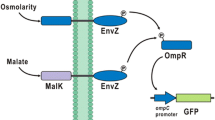Abstract
In an attempt to create an acidic amino acid-sensing Escherichia coli, a chimeric sensor kinase (SK)-based biosensor was constructed using Pseudomonas putida AauS. AauS is a sensor kinase that ultimately controls expression of the aau gene through its cognate response regulator AauR, and is found only in P. putida KT2440. The AauZ chimera SK was constructed by integration of the sensing domain of AauS with the catalytic domain of EnvZ to control the expression of the ompC gene in response to acidic amino acids. Real-time quantitative PCR and GFP fluorescence studies showed increased ompC gene expression and GFP fluorescence as the concentration of acidic amino acids increased. These data suggest that AauS-based recombinant E. coli can be used as a bacterial biosensor of acidic amino acids. By employing the chimeric SK strategy, various bacteria biosensors for use in the development of biochemical-producing recombinant microorganisms can be constructed.
Similar content being viewed by others
References
R. Faurie, J. Thommel, B. Bathe, V.G. Debabov, S. Huebner, M. Ikeda, E. Kimura, A. Marx, B. Möckel, U. Mueller and W. Pfefferle (Eds.), Microbial Production of l-Amino Acids, Advances in Biochemical Engineering/Biotechnology, Springer Berlin Heidelberg (2003).
C. Rangan and D. G. Barceloux, Dis. Mon, 55, 292 (2009).
T. Hermann, J. Biotechnol., 104, 155 (2003).
A.M. Stock, V.L. Robinson and P.N. Goudreau, Annu. Rev. Biochem., 69,183 (2000).
A. H. West and A. M. Stock, Trends Biochem. Sci, 26, 369 (2001).
P. J. A. Cock and D. E. Whitworth, Mol. Biol. Evol, 24, 2355 (2007).
R. Utsumi, R.E. Brissette, A. Rampersaud, S.A. Forst, K. Oosawa and M. Inouye, Science, 245, 1246 (1989).
A. Levskaya, A. A. Chevalier, J. J. Tabor, Z. B. Simpson, L. A. Lavery, M. Levy, E. A. Davidson, A. Scouras, A.D. Ellington, E. M. Marcotte and C. A. Voigt, Nature, 438, 441 (2005).
H. Gerken and R. Misra, J. Bacteriol, 192, 6271 (2010).
A. M. Sonawane, B. Singh and K. H. Rohm, Appl. Environ. Microbiol, 72, 6569 (2006).
I. Ganesh, S. Ravikumar, S. J. Park, S.H. Lee and S. H. Hong, Korean J. Chem. Eng, 30, 1443 (2013).
N. Ayyadurai, R. Neelamegam, S. Nagasundrapandian, S. Edwardraja, H. Park, S. Lee, T. Yoo, H. Yoon and S. G. Lee, Biotechnol. Bioprocess Eng, 14, 257 (2009).
H. Eleaume and S. Jabbouri, J. Microbiol. Meth, 59, 363 (2004).
K. Ahn, K. B. Lee, Y. J. Kim and Y.-M. Koo, Korean J. Chem. Eng, 31, 849 (2014).
P. C. Jurs, G. A. Bakken and H. E. McClelland, Chem. Rev, 100, 2649 (2000).
K. S. Kim and J.W. Ko, Korean J. Chem. Eng, 22, 26 (2005).
Author information
Authors and Affiliations
Corresponding author
Additional information
The authors contributed equally to this work.
Rights and permissions
About this article
Cite this article
Ravikumar, S., Ganesh, I., Maruthamuthu, M.K. et al. Engineering Escherichia coli to sense acidic amino acids by introduction of a chimeric two-component system. Korean J. Chem. Eng. 32, 2073–2077 (2015). https://doi.org/10.1007/s11814-015-0024-z
Received:
Accepted:
Published:
Issue Date:
DOI: https://doi.org/10.1007/s11814-015-0024-z




